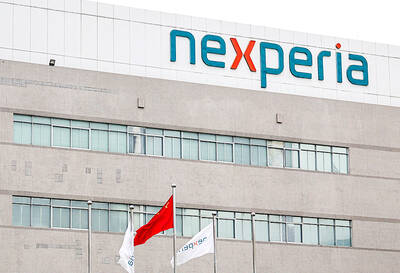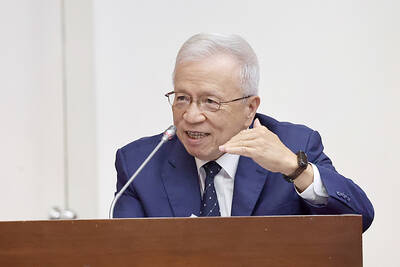Telecom equipment supplier Ericsson AB yesterday said it expects Taiwan to ramp up 5G services faster than Europe once the nation’s 5G spectrum is auctioned, thanks to its strong position in the communications components manufacturing supply chain.
The Swedish company made the comments in response to concerns that Taiwan might lag behind other advanced countries in the commercial launch of 5G networks as it did in the 4G era, when it only made 4G services available in 2014, four to five years after the world’s first 4G network had been launched.
However, that seemed not to worry Ericsson Taiwan Ltd president Chafic Nassif.
“Taiwan has an industry that manufactures a lot of components. That is not the case in many countries in Europe or elsewhere,” Nassif told a media briefing in Taipei. “Here you have the possibility of creating all kinds of ecosystems. You have a better chance of rapidly achieving scale.”
Ericsson helps local manufacturers speed up the pace of putting 5G-enabled devices on the market — including mobile phones, chips and routers — by testing their interoperability at its Taiwan-based Interoperability Center, the company’s only 5G testing lab in Asia.
MediaTek Inc’s (聯發科) new M70 5G chipset and routers from Askey Computer Corp (亞旭電腦) and Wistron NeWeb Corp (啟碁科技) have been adopted for more trials by local telecoms after completing interoperability tests at the lab.
“Taiwan is getting ready and I have a good feeling that 5G will be here in Taiwan next year, thanks to the many initiatives that have been planned by local telecoms even before December’s 5G spectrum auction,” Nassif said.
The National Communications Commission plans to auction 2,790 megahertz (MHz) of bandwidth for 5G services, including 270MHz in the 3.5 gigahertz (GHz) band, 2,500MHz in the 28GHz band and 20MHz in the 1,800MHz band.
The commission has not yet set the floor price.
In Asia, South Korea took the lead by rolling out 5G services in April. As of the middle of last month — in just three months — the country’s telecoms signed up 1.65 million 5G subscribers, Ericsson said, citing statistics from Open Signals.
South Korea took in about US$2.99 billion in its 5G spectrum auction in the summer of last year.
Ericsson expects that the number of global 5G users would reach 1.9 billion by 2024.
“I’m not saying that Taiwan is lagging behind,” Peter Fung (馮家輝), head of networks for Ericsson in Taiwan, Hong Kong and Macau, told reporters.
Taiwan has shown a readiness to embrace 5G services, given its high data usage — 20 gigabytes per month, one of the highest in the world — and its tech-savvy mobile users, Fung added.
Ericsson, which has secured 47 contracts from telecoms worldwide, is collaborating with Chunghwa Telecom Co (中華電信), Far EasTone Telecommunications Co (遠傳電信) and Asia Pacific Telecom Co (亞太電信) in the deployment of their 5G networks.

JITTERS: Nexperia has a 20 percent market share for chips powering simpler features such as window controls, and changing supply chains could take years European carmakers are looking into ways to scratch components made with parts from China, spooked by deepening geopolitical spats playing out through chipmaker Nexperia BV and Beijing’s export controls on rare earths. To protect operations from trade ructions, several automakers are pushing major suppliers to find permanent alternatives to Chinese semiconductors, people familiar with the matter said. The industry is considering broader changes to its supply chain to adapt to shifting geopolitics, Europe’s main suppliers lobby CLEPA head Matthias Zink said. “We had some indications already — questions like: ‘How can you supply me without this dependency on China?’” Zink, who also

At least US$50 million for the freedom of an Emirati sheikh: That is the king’s ransom paid two weeks ago to militants linked to al-Qaeda who are pushing to topple the Malian government and impose Islamic law. Alongside a crippling fuel blockade, the Group for the Support of Islam and Muslims (JNIM) has made kidnapping wealthy foreigners for a ransom a pillar of its strategy of “economic jihad.” Its goal: Oust the junta, which has struggled to contain Mali’s decade-long insurgency since taking power following back-to-back coups in 2020 and 2021, by scaring away investors and paralyzing the west African country’s economy.

BUST FEARS: While a KMT legislator asked if an AI bubble could affect Taiwan, the DGBAS minister said the sector appears on track to continue growing The local property market has cooled down moderately following a series of credit control measures designed to contain speculation, the central bank said yesterday, while remaining tight-lipped about potential rule relaxations. Lawmakers in a meeting of the legislature’s Finance Committee voiced concerns to central bank officials that the credit control measures have adversely affected the government’s tax income and small and medium-sized property developers, with limited positive effects. Housing prices have been climbing since 2016, even when the central bank imposed its first set of control measures in 2020, Chinese Nationalist Party (KMT) Legislator Lo Ting-wei (羅廷瑋) said. “Since the second half of

AI BOOST: Next year, the cloud and networking product business is expected to remain a key revenue pillar for the company, Hon Hai chairman Young Liu said Manufacturing giant Hon Hai Precision Industry Co (鴻海精密) yesterday posted its best third-quarter profit in the company’s history, backed by strong demand for artificial intelligence (AI) servers. Net profit expanded 17 percent annually to NT$57.67 billion (US$1.86 billion) from NT$44.36 billion, the company said. On a quarterly basis, net profit soared 30 percent from NT$44.36 billion, it said. Hon Hai, which is Apple Inc’s primary iPhone assembler and makes servers powered by Nvidia Corp’s AI accelerators, said earnings per share expanded to NT$4.15 from NT$3.55 a year earlier and NT$3.19 in the second quarter. Gross margin improved to 6.35 percent,